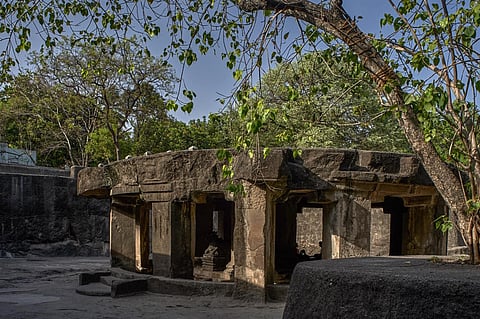
- Destinations
- Experiences
- Stay
- What's new
- Celebrating People
- Responsible Tourism
- CampaignsCampaigns
- Subscribe
- Buy Now

Imagine an ancient cave complex situated not amidst a lush green landscape hours away from the nearest city, but one that is right in the centre of a thriving urban metropolis.
Such a place does exist. The eighth-century Pataleshwar Caves lie on a busy Pune street where hawkers, restaurants, and hotels vie for business and students file in and out of a nearby public university. Dedicated to the deity of the underworld, Pataleshwar, an avatar of Shiva, the three rock-cut cave sanctums and temple are an architectural marvel, having been chiselled out of a single piece of rock.
The site is an oasis of tranquillity and peace that few visitors seek out during their holiday to “the Oxford of the East.” Here’s what makes the Pataleshwar Caves special and why they must feature on your Pune itinerary.
The Pataleshwar Caves, which are also known as the Panchaleshvara Temple or the Bhamburde Pandav Cave Temple, were carved from basalt rock and are designed in a style similar to the UNESCO World Heritage Site of the Ellora Caves. Entering the premises reveals a sanctum sanctorum, a circular Nandi mandapa (pillared hall), intricate carvings, and gigantic pillars that illustrate mythological tales from Hindu scriptures.
A notable feature of the sanctums is that they are located at a lower level, symbolising the site’s connection with the subterranean world. In the daylight, though, a stroll here is anything but scary.
One of the most eye-catching sights in the complex is the Nandi mandapa, a circular black stone structure with an umbrella-shaped canopy and sturdy square pillars which houses a statue of the divine bull Nandi, Shiva’s vahan (vehicle). It sits across from the Shiva temple, a cube-shaped room with a lingam that is flanked by a smaller cell on each side. There are also likenesses of other Hindu deities here, such as Ganesh, Ram, Lakshmi, and Sita.
A 19th-century garden now surrounds the complex, which is protected under the Archaeological Survey of India (ASI). Once visitors have had their fill of admiring the stone carvings, taking photographs of the symmetrical columns, and learning about the Pataleshwar Caves’ history at an on-site museum, they can rest under the shade of trees and find moments for introspection, even as the hubbub of the city rolls around outside them.
Constructed by Peshwa Baji Rao I in 1732, Shaniwar Wada was consumed by a devastating fire in 1828. The surviving structures remain one of Pune’s top attractions. The seven-storied palace was once an opulent seat of the Peshwas until 1818. It has five grand doors, the most important of which was the Dilli Darwaja, which faced north towards the city of Delhi. The complex also has an impressive lotus-shaped fountain called the Hazari Karanje (“fountain of a thousand jets”). Each of the 16 petals had water jets with an 80-foot arch, making it the most complicated and intricate fountain of its time.
Established in 1890, this museum showcases a diverse collection of historical artefacts, including handicrafts, weapons, taxidermied animals, agricultural displays, and industrial exhibits to provide insight into Maharashtra's culture and heritage. Originally known as The Poona Industrial Museum, it was renamed after social activist Mahatma Jyotirao Phule in 1968.
Close to the Pataleshwar Caves is the Lal Mahal, a red-coloured, palatial building that was the childhood residence of Chhatrapati Shivaji Maharaj. After the original structure fell into ruins, the current Lal Mahal was reconstructed in its place. Historically, the building is famous for an encounter between Shivaji Maharaj and Mughal general Shaista Khan, where the Maratha Emperor cut off the latter’s fingers when he was trying to escape from a window.
The months from October to February are the best time to visit the Pataleshwar Caves because of the pleasant weather.
Take a flight or train to Pune and hire a taxi to the Pataleshwar Caves on Jangali Maharaj Road.
